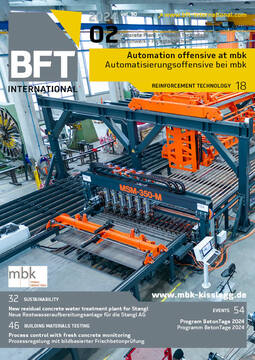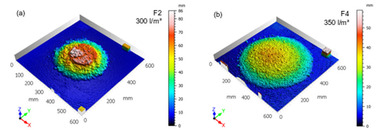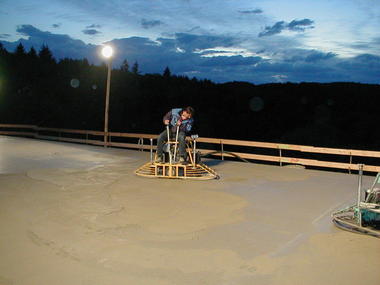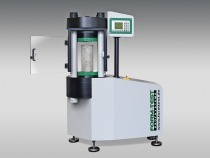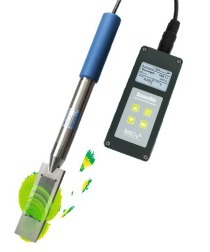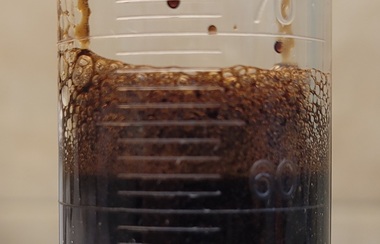Approach to digital process control with
image-based fresh concrete monitoring
Quality testing plays a decisive role in the reliable production of fresh concrete. In addition to consistency, other quantitative parameters are necessary for a comprehensive assessment of the properties. Some of these are discussed in the following article.
Introduction
Nowadays, the requirements for precast concrete parts or concrete products are being formulated more and more precisely. In addition to compressive strength, there are also requirements for geometric shape (e.g. geometry or dimensional accuracy), surface quality (structure, color, evenness, etc.) and other special properties. The surface quality requirements are influenced by both the production process and the concrete composition. For example, even slight fluctuations in the water content or water/cement ratio led to a visually perceptible change in the brightness of the concrete surface [1]. In addition, increasingly complex compositions with a variety of different raw materials are being used. On the one hand, this is the result of the imperative need to reduce the environmental impact of concrete production and, on the other, due to the increasing performance of concretes. However, such complex concrete compositions often react with reduced robustness to possible fluctuations in the raw materials or the boundary conditions [2]. Possible troubleshooting in the event of any deviations that are present and detected can be extremely complex. At the same time, only very simple test methods are available for testing concrete properties. In the DACH region, the standard test method used to assess the properties of fresh concrete is the flow table test in accordance with DIN EN 12350-5 [3]. The flow behavior or consistency of the concrete is inferred from the diameter of the spread out fresh concrete. Further quantitatively assessable information cannot yet be obtained with this test method. Only the experienced building material tester can visually recognize features on the surface of the fresh concrete, such as the agglomeration of coarse aggregates or paste separations, which allow a subjective estimation of properties.
Quality testing plays a decisive role in the reliable production of fresh concrete. In addition to consistency, other quantitative parameters are necessary for a comprehensive assessment of the properties. In addition to concrete technology parameters (e.g. consistency or homogeneity), material parameters of the concrete composition (e.g. grain size distribution or glue or water content) must be recorded as comprehensively as possible. In the production of precast concrete parts or concrete products, two basic principles can be defined for quality control depending on the time or production progress [4]:
(i) In-process inspection of raw materials, intermediate products and production steps;
ii) Testing of the finished, hardening product.
The standardized application of principle ii) is already state of the art in the production of precast concrete parts or concrete products. Although more and more processes and methods are being developed and integrated into the manufacturing process to implement principle i), it is not yet possible to record disturbing influences or quality deviations in the fresh concrete in real time, including digital quality control. In particular, the high demand for precast concrete parts (e.g. the increased demand for precast concrete walls and floors in 2020 by 3.5% compared to the previous year to around 31.9 million m² [5]) and the enormous repetition rates in fresh concrete production resulting from discontinuous production predestine the industry for the introduction of digital methods both for quality testing and especially for digital quality control. Initial approaches to digital testing of aggregates during production are presented in [6, 7]. Further methods for digital quality inspection and control during the entire process chain from fresh concrete production to placement are also included in [8, 9], among others.
This paper presents an approach for digital process control of fresh concrete properties in the context of precast concrete production. The approach is based on a methodology for the image-based evaluation of (fresh) concrete properties as part of the flow table test. The image-based digital evaluation of the properties offers the possibility to integrate the determined property parameters directly into a digital process or quality control of concrete production, both in the precast concrete or concrete goods sector and in the ready-mixed concrete sector. Any quality deviations detected can thus be adjusted much more efficiently (in terms of time) and concrete production can be controlled more consistently.
Development of a image-based method for fresh concrete quality control
In order to overcome the limitations of subjective visual inspection, an image-based methodology was developed and validated that allows decisive (fresh) concrete properties to be automatically recorded and digitally evaluated as part of the flow table test. By applying photogrammetric measurement principles in combination with modern digital image analysis methods and artificial intelligence methods (e.g. Convolutional Neural Networks), decisive (fresh) concrete properties can be predicted from image data of the spread out fresh concrete. The range of properties to be determined as part of the quality inspection of the fresh concrete is thus significantly expanded by a large number of additional parameters and properties.
The method developed is based on the determination of the visually recognizable appearance of the fresh concrete. Changes in the properties as well as the composition led to changes in the surface properties of the spread fresh concrete when carrying out the flow table test. For example, changes in the surface shape or texture as well as changes in reflection can be visually perceived. The aim was to digitize the recording and evaluation of these previously purely subjectively perceived characteristics using the developed methodology. After carrying out the flow table test, images are taken of the spread out fresh concrete using a standard SLR camera in order to automatically derive quality characteristics from the image data based on the determined surface properties. The image-based method determines and evaluates 3D surface characteristics, geometric 2D and reflection-based characteristics in the image data as characteristic values or properties of the spread fresh concrete surface [10]. Fig. 1 provides a schematic overview of the individual steps.
Various digital evaluation methods are used to determine the surface properties and characteristics. On the one hand, a 3D model of the fresh concrete surface can be calculated using photogrammetric measurement principles. For this purpose, several images of the fresh concrete are taken from different angles. External control points on the flow table allow the calculation of a 3D model from the recorded image data. For the basics of photogrammetric 3D reconstruction, please refer to the basic literature, e.g. [12]. Based on the data of the 3D surface model, 3D surface values can be calculated in a further step. 3D surface parameters, e.g. according to DIN EN 25178-2 [13], are used as standard in the metal processing industry (e.g. in sheet metal forming) to characterize and evaluate surface properties. These standard parameters were adapted to describe and evaluate the fresh concrete surface. For example, the surface parameter Sku (kurtosis), which describes the steepness or sharpness of a surface, offers a way of evaluating changes in the properties of fresh concrete.
Application of the image-based methodology
The image-based methodology described above enables a digital evaluation of a large number of concrete technology properties and parameters as part of the flow table test. For example, in addition to consistency, the particle size distribution of the coarse aggregate (≥ 4 mm), the maximum particle size and particle shape, the paste content or the homogeneity of the fresh concrete can be digitally evaluated directly as part of the flow table test using image data [10]. The range of properties that can be evaluated as part of the flow table test is thus significantly expanded, enabling a comprehensive assessment of the concrete composition and its properties.
To evaluate individual properties, such as the tendency to separate water or fluctuations in water content, previously defined or determined target values are required. A target/actual comparison of the quality characteristics of the fresh concrete is then possible as part of the flow table test. Deviations, e.g. in water content, can thus be accurately estimated. Fig. 2 shows an example of the change in surface shape in the 3D model as a function of systematic water overdosing (10 and 15 l/m³) with otherwise identical boundary conditions. The visually clearly changed surface shape depending on the water overdosing can be expressed by the surface parameter Sku (see section ‚Method development‘ or refer to [10] for a detailed description of Sku). Fig. 3 shows the relative change in the properties of the spreading dimension (a10) and the surface parameter Sku of different concrete compositions as a function of water overdosing.
It is clear that the change in the surface parameter Sku is more pronounced than that of the diameter as a measure of consistency. Accordingly, the surface parameter Sku reacts more sensitively to water content fluctuations than the spreading dimension in the spreading dimension test. As a result, water content fluctuations can be systematically evaluated by the relative change in the surface parameter Sku with increased selectivity as part of the spreadability test. The relatively large scattering ranges in Fig. 3 indicate that a generally valid evaluation of diverse concrete compositions with differing properties is only possible with certain deviations. However, if the influence of water content fluctuations is already examined in the initial test and thus calibrated for the specific concrete using the surface parameter Sku0 of the initial concrete composition without water content fluctuation, very high precision is possible. Such a possible procedure for evaluating a water overdosage or possible water content fluctuations by means of the relative change in Sku with integration of the initial test is summarized schematically in Fig. 4.
Assuming that possible fluctuations in other raw materials (cement, additives or superplasticizers) can be controlled relatively accurately via the digital weighing data during the mixing process, the use of image-based fresh concrete testing offers a simple method for detecting possible water content fluctuations in the production process, e.g. as a result of fluctuating moisture content of the aggregate. Although minor fluctuations in the water content usually only have a relatively small effect on the consistency of the fresh concrete (see Fig. 3), they can lead to significant reductions in compressive strength or changes in the color of the hardened concrete.
Approach to digital process control
The image-based methodology presented in this article is an easy-to-use tool for the comprehensive digital evaluation of (fresh) concrete properties. Both material properties (particle size distribution, maximum particle size, particle shape or paste content) and concrete technology properties (consistency and homogeneity) can be determined and evaluated in digital form as part of the flow table test. The image-based method therefore makes it possible to convert the quality control of fresh concrete, which is currently highly subjective, into a quantitative assessment of relevant (fresh) concrete properties. A decisive advantage here is the digital recording of the characteristic values and the property evaluation, as this enables direct integration into the production cycle and the production process can be digitally controlled with data from the fresh concrete. Any quality deviations detected can be adjusted much more efficiently (in terms of time) and the production process can be controlled more consistently. This offers opportunities for digital process control of fresh concrete production, particularly in the manufacture of precast concrete parts or concrete products, as the repetition factor is extremely high here due to the relatively low number of changes in concrete compositions. Any fluctuations, e.g. in the moisture content of the aggregate, that lead to changes in the fresh concrete properties can be digitally recorded using the method described and taken into account accordingly in the production cycle. In this way, corresponding ‚trends‘ in the development of the properties can be recognized and controlled at an early stage using the digital data in so-called quality control charts (e.g. Shewhart and CUSUM control charts [14]), see Figure 6.
In addition, the collection of digital data offers new possibilities for the integration of comprehensive process management systems from development to production and processing of the concrete. For example, the collected data and the resulting recorded fluctuations and properties can be used to develop more sustainable and resource-efficient concrete compositions by applying appropriate big data methods.

![Fig. 1: Schematic overview of the individual steps of the developed image-based methodology for the digital determination and evaluation of (fresh) concrete properties [11]](https://www.bft-international.com/imgs/2/0/4/8/6/8/6/tok_b544fb775c74b6ecde9dd5ee4805ecc7/w300_h200_x600_y173_HA_1233_Fig.1_Bild_1-2b1c9a2a13f01a84.jpeg)
![Fig. 2: Detailed view (Ø = 350 mm) of the 3D surface models of spread out fresh concretes for different water overdosages - left: Reference concrete composition (± 0 l/m³); center: + 10 l/m³; right: + 15 l/m³ [10]](https://www.bft-international.com/imgs/2/0/4/8/6/8/6/tok_189ee52a9787cc46ff61ceb43168b8c1/w300_h200_x600_y144_HA_1233_Fig.2_Bild_3-e07e4fbee48d8fc2.jpeg)
![Fig. 3: Relative change in properties as a function of water overdosing (5-20 l/m³) - flow diameter a10 and surface parameter Sku [10]](https://www.bft-international.com/imgs/2/0/4/8/6/8/6/tok_3c2b29efdeeab5ba1a034da5b42ba98a/w300_h200_x600_y593_HA_1233_Fig.3_Bild_4-3bea2f2d1dfed86c.jpeg)
![Fig. 4: Schematic overview of the evaluation of a water overdose (WÜ) including the initial test using the surface parameter Sku [10]](https://www.bft-international.com/imgs/2/0/4/8/6/8/6/tok_07c2511651961be80f21b33e4a43b87a/w300_h200_x600_y324_HA_1233_Fig.4_Bild_5-9702219ff97d0e97.jpeg)




